The excuse for my visit to Paris was SmartCity, a conference organized in the frame of the festival Emergences. Emergences is an ‘international festival of electronic cultures and new art forms’. However, one must accept that in a city like Paris the word ‘international’ doesn’t necessarily that tacit rules will be respected and that the activities and conferences will be held in any other language than french. That’s probably why i enjoyed the event so much. While both the issues discussed and the quality of the speakers invited to the panels were definitely of international relevance, the festival had a homely feeling with an audience ready to participate and dialog, un-refrained as they were by any lack of knowledge of the ubiquitous english.

The conference focused on urban activism and artistic interventions in public space, a theme which offered a splendid contrast with the venue of the conference: the very chichi Maison Internationale at the Cité Internationale Universitaire de Paris.
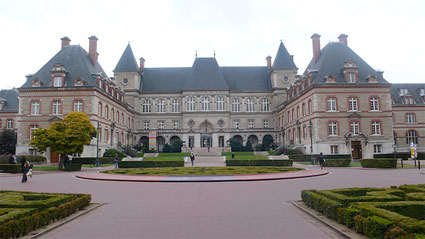 Perfect venue to discuss alternative uses of urban space
Perfect venue to discuss alternative uses of urban space
There were some good moments but the one that got me glued to my seat, pen in the hand and eyes on the screen was the presentation of mOmentoMoNUMENTO, a joint project by Brazilian collective Coloco & French experimental architects of Exyzt whose pavilion at the Venice architecture biennale of 2006 i had enjoyed so much.
Exyzt’s works engage mostly with temporary interventions, ephemeral constructions and the presence of diversity in urban space. They have recently joined forces with Coloco to submit to the institution Cultures France a project that will be part of the official programme of the French Year in Brazil (February-July 2009).
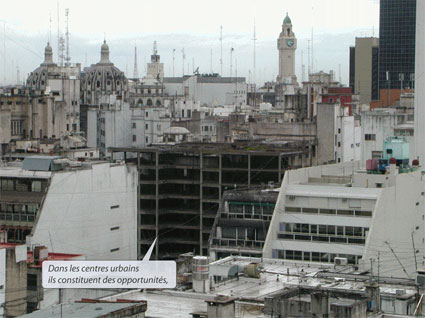 When located in urban centers, skeletons provide opportunities
When located in urban centers, skeletons provide opportunities
The final project stems from a research started in 2001 by Coloco.
The Brazilian collective observed, analyzed and documented a phenomenon called ‘skeleton dwellings’: in big cities, groups of people decide to occupy then inhabit buildings which were left unfinished and abandoned because of economic crisis, ups and downs of the estate market, war, cataclysm, etc.
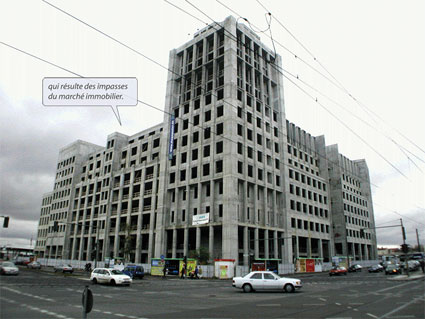 Result of the dead-end of the estate market
Result of the dead-end of the estate market
The desire of these people is to live in the center of the city, close to the services. They organize the general functioning of the building: bathroom and garden for the collectivity are installed, trash collection is organized, spaces on ground levels are reserved for the elderly, etc. Sometimes, the dwellers are kicked out of the building but in some cases, they manage to reach an agreement with city officials (conscious that the abandon of the center of a city for the suburbs is a growing problem) and their dwelling become permanent and ‘legitimate’.
Coloco came to consider that these inhabited skeletons of buildings give way to an unexpected collaboration between the construction industry and invention prompted by necessity. This idea is at the origin of the skeleton dwellings: a safe and assembled structure is supplied to a group of inhabitants-builders. It can be improved according to the needs and resources of its occupants, who contribute their labor, advised by professionals.
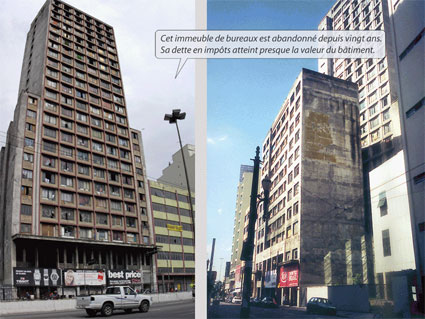 Prestes Maia (Sao Paulo): This building has been abandoned 20 years ago. Its debt in taxes almost equals its value
Prestes Maia (Sao Paulo): This building has been abandoned 20 years ago. Its debt in taxes almost equals its value
The skeleton dwellings derive from a logic of opportunity, being easily inserted in dense urban areas and diversifying the supply of low-cost urban housing.
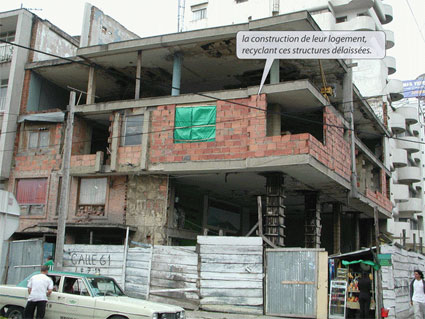 Building their dwellings, recycling these abandoned structures
Building their dwellings, recycling these abandoned structures
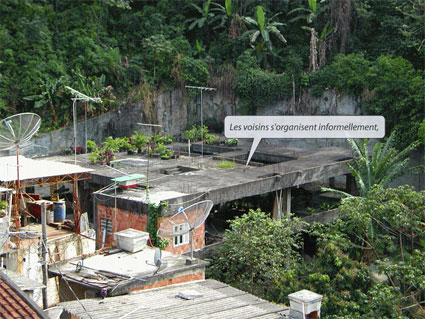 Neighbours organize themselves informally
Neighbours organize themselves informally
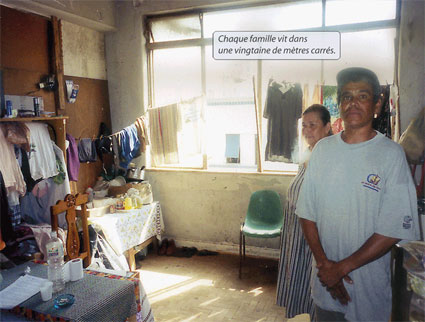 Prestes Maia (Sao Paulo): Each family lives in roughly 20 sqm
Prestes Maia (Sao Paulo): Each family lives in roughly 20 sqm
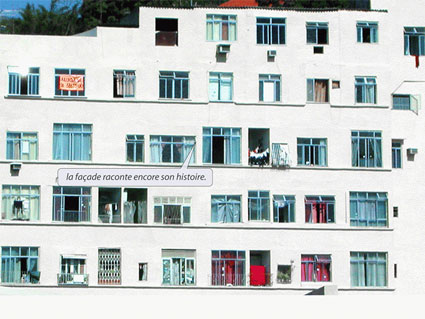 Gloria, Rio de Janeiro: Even after renovation, some facades can’t hide their history
Gloria, Rio de Janeiro: Even after renovation, some facades can’t hide their history
Meanwhile, Exyzt is also working on the rehabilitation of disused spaces and on alternative and cheap forms of dwellings.
A first project they presented is République Ephémère where 450 architectural students from Europe were given some rudimentary tools and materials to organize for 2 weeks their life as a big community in the enclosed space of the two wharehouses?
The challenge took the form of a one-to-one scale construction game that doubled as a laboratory of architectural and social research. The conceptor team built the main collective equipment (kitchen, washrooms, a hotel) beforehand. The rest would be a village autoconstructed and automanaged by its inhabitants.
Each student was untrusted with a survival kit, including a construction manual and security instructions, and a defined quantity of scaffolding and textiles. Geometrical problems could arise, as this amount of scaffolding, sufficient to build one cubic room could then be combined with others: for example, 2 kits put together could give rise to 3 dwellings.
Video:
The affinities and exchanges between the participants were gradually translated into architectural terms. More complex, personalized structures were developed over time. The implantation looked like a cross between an organic. medieval village and a refugee camp. It kept transforming itself, not only on the level of the individual sphere, but also on the level of the collective organization.
The second project Exyzt spotlighted was an intervention inside and outside of the Palast der Republik, a gigantic relic of the communist era, now demolished and about to be replaced by the (very tacky imho) reconstruction of its predecessor, the Berlin Stadtschloss.
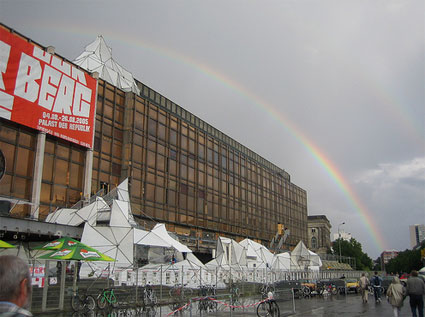 Der Berg (image southwarklido)
Der Berg (image southwarklido)
Under the menace of a demolition act, Raumlabor, one of the most brilliant group on the German architecture scene, decided to occupy and open the monument to the public. They called Exyzt to give them a helping hand.
Der Berg (in german: the mountain) is an artificial mountain, a surrealist architectural performance built to react to the absurdity of making a tabula rasa of a part of Berlin’s history in order to build the replica of a long disappeared building.
This collaboration resulted in a 20 meters high triangulated structure made out of scaffolding and fiber glass textile. The installation invaded the theater, while another team made it spread through the roof and onto the front porch of the building. Der Berg became a monument inside a monument.
Movie:
After this introduction, Exyzt and Coloco focused on mOmentoMoNUMENTO, the project they are working on for the official programme of the French Year in Brazil (February-July 2009). The idea is to follow on the steps of the French tradition to ‘offer’ monuments to foreign countries (think of the Statue of Liberty). This monument, however, is already on site. Well, sort of. The architects have obtained the help of the city of Sao Paulo to spot one of the many skeletons that have been standing for years in the city center, waiting to be reconquered by Exyzt and Coloco.
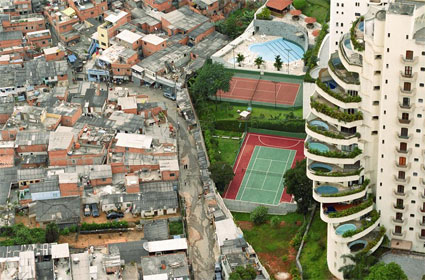 Saõ Paulo: an apartment building for the wealthy overlooks a favela, ironically called Paraisópolis (Paradise city). Photo: Luiz Arthur Leirão Vieira (bigger view)
Saõ Paulo: an apartment building for the wealthy overlooks a favela, ironically called Paraisópolis (Paradise city). Photo: Luiz Arthur Leirão Vieira (bigger view)
The building they’ve set their sight on was built in 1965. It is the first building with a facade entirely made of glass. Occupied at some point by the federal police it has now been left to decay. The main problem the architect have to solve is that living inside the building is almost un-conceivable without air conditioning which has been dismantled in the meantime. The whole electrical setting has to be re-installed as well (especially if one wants to have access to the top floor by lift.)
The project responds to Sao Paulo government’s desire to find new solutions that will inject life back into the center of the city: inhabitants have moved to the edge of the city, leaving many abandoned buildings and a thick infrastructure of roads behind them.
The building is left at the disposal of the architects for one year. If at the end of the project, the result is deemed good enough by the city, it could become a space left permanently occupied by cultural organizations, art galleries, artists residencies, etc.
Exyzt and Coloco want to make the rooftop (originally planned as a landing spot for helicopters) accessible to the public.
The project is currently self-funded. Any help and feedback would be most welcome.
Related: Global Cities, The Morrinho Project at the Venice Biennale and Juan Freire – From the Analogue Commons to the New Hybrid Public Spaces.
